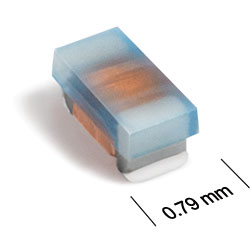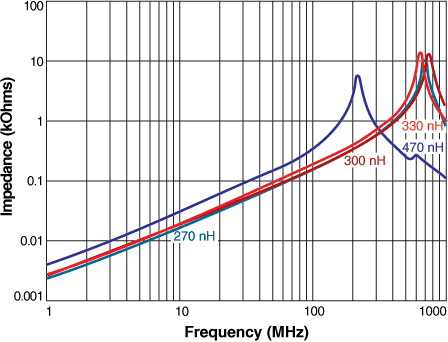
3D Model
Datasheet
AR235RAP Series
Chip Inductors for Critical Applications
AR235RAP Series chip inductors feature higher inductance values than other 0402 ceramic chip inductors.
- Exceptionally high Q factors
- Outstanding self-resonant frequency
- Tight inductance tolerance
- High temperature materials allow operation in ambient temperatures up to 155°C.
- Passes NASA low outgassing specifications
- Standard tin-lead (Sn‑Pb) terminations ensures the best possible board adhesion. Note: Nickel barrier termination (tin-lead over tin over nickel over silver-platinum-glass frit, termination code P) is recommended for hand soldering applications.
Specifications
Electrical specifications at 25°C.
| Part number 1 |
Inductance (nH)
2
(Tolerance: ± 5%) |
Q min 3 | SRF min (MHz) 4 | DCR max (Ω) 5 | Imax (mA) |
|---|---|---|---|---|---|
| AR235RAP430JPZ | 43 @ 250 MHz | 21 @ 250 MHz | 2900 | 0.75 | 250 |
| AR235RAP510JPZ | 51 @ 250 MHz | 21 @ 250 MHz | 2700 | 0.85 | 240 |
| AR235RAP560JPZ | 56 @ 250 MHz | 21 @ 250 MHz | 2600 | 0.90 | 240 |
| AR235RAP680JPZ | 68 @ 250 MHz | 11 @ 100 MHz | 760 | 0.85 | 230 |
| AR235RAP720JPZ | 72 @ 250 MHz | 12 @ 100 MHz | 720 | 0.90 | 210 |
| AR235RAP750JPZ | 75 @ 250 MHz | 11 @ 100 MHz | 700 | 0.90 | 210 |
| AR235RAP820JPZ | 82 @ 250 MHz | 11 @ 100 MHz | 680 | 0.95 | 210 |
| AR235RAP900JPZ | 90 @ 250 MHz | 11 @ 100 MHz | 560 | 1.00 | 210 |
| AR235RAP910JPZ | 91 @ 250 MHz | 10 @ 100 MHz | 560 | 1.00 | 200 |
| AR235RAP101JPZ | 100 @ 250 MHz | 10 @ 100 MHz | 680 | 1.05 | 200 |
| AR235RAP111JPZ | 110 @ 250 MHz | 10 @ 100 MHz | 670 | 1.10 | 190 |
| AR235RAP121JPZ | 120 @ 250 MHz | 11 @ 100 MHz | 530 | 1.15 | 190 |
| AR235RAP151JPZ | 150 @ 100 MHz | 10 @ 100 MHz | 640 | 1.35 | 180 |
| AR235RAP181JPZ | 180 @ 100 MHz | 9 @ 100 MHz | 510 | 1.45 | 170 |
| AR235RAP201JPZ | 200 @ 100 MHz | 9 @ 100 MHz | 510 | 1.55 | 170 |
| AR235RAP221JPZ | 220 @ 100 MHz | 9 @ 100 MHz | 540 | 1.70 | 170 |
| AR235RAP271JPZ | 270 @ 25.0 MHz | 8 @ 25.0 MHz | 470 | 1.95 | 160 |
| AR235RAP301JPZ | 300 @ 25.0 MHz | 8 @ 25.0 MHz | 480 | 2.15 | 160 |
| AR235RAP331JPZ | 330 @ 25.0 MHz | 8 @ 25.0 MHz | 410 | 2.23 | 150 |
| AR235RAP361JPZ | 360 @ 25.0 MHz | 8 @ 25.0 MHz | 388 | 2.36 | 140 |
| AR235RAP391JPZ | 390 @ 25.0 MHz | 8 @ 25.0 MHz | 208 | 2.35 | 140 |
| AR235RAP471JPZ | 470 @ 25.0 MHz | 8 @ 25.0 MHz | 176 | 2.67 | 130 |
Notes
- When ordering, please specify termination and testing codes: e.g. AR235RAP471JPZ.
- Inductance measured using a Coilcraft SMD-F test fixture and Coilcraft-provided correlation pieces with an Agilent/HP 4286A impedance analyzer or equivalent.
- Q measured using an Agilent/HP 4291A with an Agilent/HP 16197A test fixture or equivalents.
- SRF measured using an Agilent/HP 8753ES network analyzer and a Coilcraft CCF1232 test fixture.
- DCR measured on a Keithley 580 micro-ohmmeter and a Coilcraft CCF1010 test fixture.
Termination:
- P = Tin-lead (63/37) over tin over nickel over silver-platinum-glass frit.
- S = Tin-lead (63/37) over leach-resistant silver-platinum-glass frit.
- L = Silver-palladium-platinum-glass frit.
Testing:
- Z = Unscreened
- H = Group A screening per Coilcraft CP-SA-10001
- 1 = EEE-INST-002 (Family 3) Level 1
- 2 = EEE-INST-002 (Family 3) Level 2
- 3 = EEE-INST-002 (Family 3) Level 3
- 4 = MIL-STD-981 (Family 50) Class B
- 5 = MIL-STD-981 (Family 50) Class S
- F = ESCC3201 (F4 operational life performed at 90°C)
- Screening performed to the document’s latest revision.
- Lot qualification (Group B) available.
- Custom testing also available.
- Country of origin restrictions available; prefix options G or F.
Environmental
Ambient temperature range:
–55°C to +125°C with Irms current.
Storage temperature range:
Component: –55°C to +155°C.
Tape and reel packaging: –55°C to +80°C.
Tape and reel packaging: –55°C to +80°C.
Maximum part temperature:
+155°C (ambient + temp rise).
Failures in Time (FIT) / Mean Time Between Failures (MTBF):
Performance curves
Typical L vs Frequency

Typical Q vs Frequency

Typical Impedance vs Frequency

General specification
Core Material:
Ceramic
Weight:
0.7 – 1.3 mg
Packaging:
2000 per 7″ reel. Paper tape: 8 mm wide, 0.66 mm thick, 2 mm pocket spacing
Temperature coefficient of inductance:
+25 to +150 ppm/°C.
Soldering/Washing
Moisture Sensitivity Level (MSL):
1 (unlimited floor life at <30°C / 85% relative humidity).
Resistance to soldering heat:
Max three 40 second reflows at +260°C, parts cooled to room temperature between cycles.
Refer to Soldering Coilcraft Components before soldering.